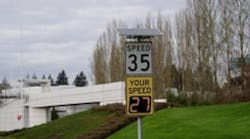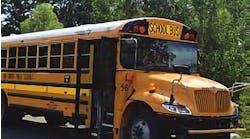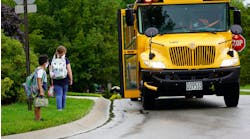Schools and universities looking to be safer and prevent accidents should review their pedestrian-safety efforts. Many school-age children die from motor vehicle accidents, and a majority of these accidents happen in and around school zones, and during hours where children are most likely to be traveling to and from school.
Universities also are reporting increased pedestrian accidents on and around campuses. With bicyclists, moped riders and pedestrians going to and from classes, these environments are particularly conducive to collisions and other accidents.
Over the last several years, a variety of research has assessed the effectiveness of pedestrian-safety programs. The objective of these studies was twofold: to determine the most effective means of reducing the number of pedestrian accidents and to learn how to best decrease the severity of accidents that do occur.
In one study, researchers found that marked crosswalks had no effect on reducing pedestrian accidents. Even more counterintuitive was a finding that on heavy-traffic, multi-lane streets, marked crosswalks were associated with greater numbers of pedestrian accidents — not fewer.
Making a plan
These findings, coupled with the availability of new technologies and new programs aimed at increasing pedestrian safety, suggest that education institutions can improve their safety efforts. Five suggestions school safety officials and administrators should consider when developing a pedestrian-safety or traffic-calming program:
-
Reducing speeds by as little as 5 miles per hour can save lives. A number of studies have come to the same conclusion: a direct and significant relationship exists between vehicle speed and pedestrian injury, and a few miles per hour can make the difference between a cast or a casket. A 1999 study by the U.S. Department of Transportation found that only 5 percent of pedestrians would die when struck by a vehicle traveling 20 miles an hour or less. That jumps to 40 percent when the car is going 30 miles an hour, 80 percent at 40 miles an hour, and nearly 100 percent at 50 miles an hour.
-
Some common methods used for slowing traffic may not be suitable in educational environments. Safety experts often find traditional traffic-calming methods to be particularly inappropriate for use around school zones and colleges campuses. Rumble strips or speed bumps, for instance, have been found to be hazardous to bicyclists and moped drivers as well as skateboarders and others using smaller-wheeled modes of transportation.
Studies have shown that speed bumps can be highly effective in slowing cars, but they may be unacceptable when placed next to classrooms and offices because of the increased traffic noise that researchers found they cause. Speed bumps also commonly are banned on streets designated for use by ambulances, fire trucks and other emergency vehicles.
-
Some common traffic-calming solutions may not work as expected. As mentioned, some studies have shown that marked crosswalks are often the scenes of increased — rather than decreased — pedestrian accidents. Some researchers blame this phenomenon on an inappropriate level of safety confidence that these markings instill. Others suggest that the marked crosswalks are either difficult to see or simply ignored by drivers. Some studies, however, suggest that the effectiveness of crosswalks significantly increases when used alongside other safety devices such as raised median strips, streetlights and flashing warning signs.
Studies also indicate that the use of stop signs and even speed limit signs actually may have a negative effect on efforts to slow traffic. Researchers have found that drivers faced with a continual succession of these signs often get frustrated and actually speed up between each posting. These signs also tend to simply divert drivers to other streets, merely moving the problem to a new location.
-
New speed-calming technologies offer some fresh alternatives. Over the last several years, new technologies have been applied to the age-old problem of speeding drivers. Now that empirical data, as well as anecdotal reports, are proving their effectiveness, the use of these technologies by safety experts is on the rise.
Photo speed signs have been shown to be highly effective on highways and other areas where voluntary compliance with speed laws has been less than satisfactory. In some cases, neighborhood groups and traffic engineers, as well as police officials are using radar speed guns. The visible presence of someone using these devices often times is all that is required to slow cars. In addition, researchers have found that combining this technology with follow-up visits to offenders has proven to increase the long-term effectiveness of this approach.
Radar speed signs (also known as “Your Speed” signs) also have become popular among government agencies and safety engineers looking to increase pedestrian safety. Many motorists that drive too fast do so less because of a flagrant desire to break the law, and more because of their own perceptions of what is a safe driving speed at any given time. Research suggests that the highly effective nature of radar speed signs is because of their ability to direct a driver's attention back to his or her own speed. This is increasingly important as the use of iPods, cell phones and other distracting devices grows among drivers.
The increased use of these signs is, in large part, because of their versatility. They can be mounted temporarily in various trouble spots or installed permanently for 24/7 operations. Some signs come with advanced capabilities that allow users to set hours of operation (such as during commute times or during school hours), record traffic data or control external warning devices such as flashing lights.
-
Consider applying for grants or other funding assistance. Shrinking budgets have reduced or eliminated many traffic-calming programs, but government agencies offer alternative funding options that help pay for traffic-safety measures. This is particularly true if the project involves increasing the safety of schoolchildren.
Finding applicable grants often starts with a thorough Internet search. The trick is to use keywords that will get you the information you need and eliminate a lot of useless websites. Some suggested search terms include public safety federal grants, pedestrian safety, traffic calming, discretionary grants and project grants.
Often, vendors involved in traffic-calming solutions work closely with schools to find appropriate funding programs.
Kelley is founder of www.stopspeeders.org, a website dedicated to offering information on various traffic-calming technologies and research.
23
Percentage of all child pedestrians between the ages of 5 and 9 killed in traffic crashes (2002).
Source: National Center for Statistics & Analysis of the National Highway Traffic Safety Administration
Want to know more about safety and transportation?
Take a look at the article archives at www.asumag.com.




